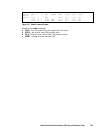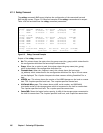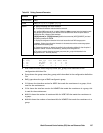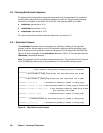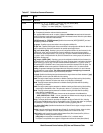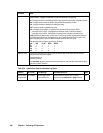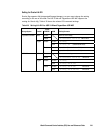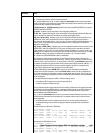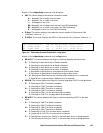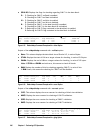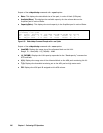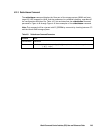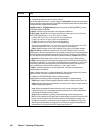
Hitachi Command Control Interface (CCI) User and Reference Guide 243
Parameter Value
Options -h: Displays Help/Usage and version information.
-q: Terminates the interactive mode and exits the command.
-z or -zx (OpenVMS cannot use the -zx option): Makes the raidvchkdsp command enter the interactive
mode. The -zx option guards performing of the HORCM in the interactive mode. When this option detects a
HORCM shut down, interactive mode terminates.
-I[H][M][instance#] or -I[TC][SI][instance#] Specifies the command as [HORC]/[HOMRCF], and used for
specifying instance# of HORCM.
-g <group>: Specifies a group name written in the configuration definition file.
-d <pair Vol>: Specifies paired logical volume name defined in the configuration definition file. When this
option is specified, the command is executed for the specified paired logical volume.
-d[g] <raw_device> [MU#]: Searches a group on the configuration definition file (local instance) for the
specified raw_device, and if the specified raw_device is contained in the group, the target volume is
executed as the paired logical volume (-d) or group (-dg). This option is effective without specification of “-g
<group>“ option. If the specified the raw_device is contained in two or more groups, the command is
executed on the first group.
-d[g] <seq#> <LDEV#> [MU#]: Searches a group on the configuration definition file (local instance) for the
specified LDEV, and if the specified LDEV is in the group, the target volume is executed as the paired
logical volume (-d) or group (-dg). This option is effective without specification of “-g <group>“ option. If the
specified LDEV is contained in two or more groups, the command is executed on the first group. The <seq
#> <LDEV #> values can be specified in hexadecimal (by addition of “0x “) or decimal notation.
-fx: Displays the LDEV/STLBA/ENLBA number in hexadecimal.
-fd: Displays the relation between the Device_File and the paired Volumes, based on the Group (as
defined in the local instance configuration definition file). If Device_File column shows “Unknown” to HOST
(instance) (Figure 4.33), then the volume is not recognized on own HOST, and raid
vchkdsp command will
be rejected in protection mode. Non-permitted volume is shown without LDEV# information (LDEV# is “– ”).
-fe: Displays the serial# and LDEV# of the external LUNs mapped to the LDEV for the target volume
(Figure 4.33) by adding to last column (ignores the format of 80 column).
-c: Wh
en RAID Manager starts, HORCM_DEV in horcm.conf will be translated from Port/target/lun
numbers to the CU:Ldev information, on one hand HORCM_LDEV in horcm.conf will be translated from
the CU:Ldev information to Port/target/lun numbers, because RAID needs to specify "Port#, Targ#, Lun#"
and “LDEV” for specifying the target device, and then HORCM keeps this information as internal database
for the configuration.
If a storage administrator changes the LDEV to LUN/port mapping, such as
a new/different LDEV is mapped to a previously used port/LUN, or
an LDEV is mapped to a different/new port
then pair operations might be rejected because the new mapping is different from the mapping information
the database in the running HORCM instance. A pairdisplay command shows the real LDEV mapping at
the time of the command execution and hence shows different information than what is stored in the
internal database of the HORCM instance.
The “-c” option for raidvchkdsp allows the user to see if there is a difference between the current running
HORCM instance information and the real mapping. This indication should be used to find such issues
which indicate that:
the HORCM instance should be restarted to discover and use the new mapping information, or
a configuration change occurred without changing the affected configuration files of the HORCM
instance.
Example change from LDEV#785 to LDEV#786:
# raidvchkdsp -g VG000 -c
Group PairVol Port# TID LU Seq# LDEV# LDEV#(conf) -change-> LDEV#
VG000 vg0001 CL4-E-0 0 17 63528 786 785(conf) -change-> 786
# raidvchkdsp -g VG000 -c -fx
Group PairVol Port# TID LU Seq# LDEV# LDEV#(conf) -change-> LDEV#
VG000 vg0001 CL4-E-0 0 17 63528 312 311(conf) -change-> 312
Example remove LDEV#785 from a port:
# raidvchkdsp -g VG000 -c
Group PairVol Port# TID LU Seq# LDEV# LDEV#(conf) -change-> LDEV#
VG000 vg0001 CL4-E-0 0 17 63528 - 785(conf) -change-> NO LDEV
# raidvchkdsp -g VG000 -c -fx
Group PairVol Port# TID LU Seq# LDEV# LDEV#(conf) -change-> LDEV#
VG000 vg0001 CL4
-
E
-
0
0 17 63528
-
311(conf) -change
-
>
NO LDE
V



